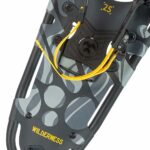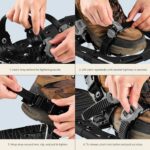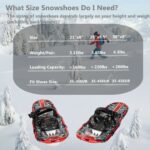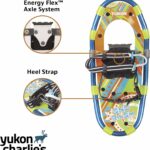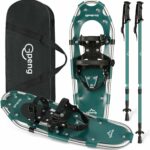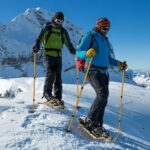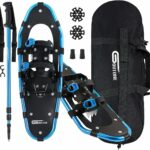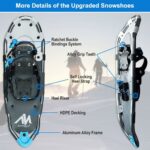Strap on your snowshoes and get ready to embrace the snowy landscape that awaits you. “How To Walk on Snowshoes” is a comprehensive guide offering detailed instructions on everything you need to take your first steps with snowshoes. Whether it’s about navigating through powdery plains or dealing with slopes and icy terrains, this article has got you covered. With clear directions and tried-and-true tips, you’ll be confidently trekking through the winter wilderness in no time.
Understanding the Basics of Snowshoes
Snowshoeing is an increasingly popular winter sport, that offers a fun, inexpensive way to explore the winter landscape and get a bit of exercise at the same time. Before you get started on your snowshoeing adventure, you might want to understand the basics of what snowshoes are, how they work, and the different types available.
What are snowshoes?
Snowshoes are specialized footwear designed for walking over snow. They work by distributing your body weight over a larger area which prevents your feet from sinking completely into the snow, a concept known as flotation.
How do snowshoes work?
The wide base of the snowshoe causes a redistribution of your weight, spreading it out so that your foot doesn’t sink into the snow. Think of it as a buoyancy aid for snow. The snowshoe is larger at the front to help you step forward, and are often equipped with crampons or grips under the toes to provide traction.
Different types of snowshoes
There are three main types of snowshoes: recreational, backcountry and running. Recreational snowshoes are designed for flat or gently rolling terrain, backcountry snowshoes are built for rugged, mountainous terrain and running snowshoes are the lightest and smallest, designed for speed rather than flotation.
Choosing the Right Snowshoes
Selecting the right pair of snowshoes can enhance your experience on the trails. Here are some factors to consider when making your selection.
Factors to consider when buying snowshoes
Firstly, you’ll want to consider what type of snowshoeing you plan to do. Recreational, backcountry, or running? Secondly, your physical size and fitness level will influence which snowshoes are best for you. Last, but not least: consider the type of snow and terrain typically encountered in the area in which you’ll be snowshoeing.
Suitable snowshoes for beginners
If you’re a beginner, start with recreational snowshoes. They’re easier to use and less expensive than other types. Look for a pair that comes with poles, which can help with balance.
Different sizes and materials
Snowshoes are sized based on the weight they need to support including the weight of any gear you might be carrying. Larger snowshoes offer more flotation, smaller models offer less. Frames are typically made of either aluminum or composite material with decking made of durable, lightweight synthetic material.
Dressing for Snowshoeing
Dressing appropriately for your snowshoeing adventure can make the difference between a good experience and a cold, miserable one.
Essential clothing for snowshoeing
Dress in layers to help regulate body heat. Your base layer should be moisture-wicking, next a layer to insulate, and finally a waterproof outer layer. Don’t forget gloves, hats, and sunglasses for protection against sun and wind.
Factors affecting clothing choice
Weather is the primary factor affecting clothing choice. If conditions are likely to change, wear layers that can easily be added or removed. Also consider the intensity of your activity – higher intensity workouts require less, lighter clothing.
Footwear and socks for snowshoeing
Insulated, waterproof boots are ideal. They should be comfortable and large enough to accommodate thick, wool or synthetic socks that wick away moisture to keep your feet dry.
Preparing for Your Snowshoeing Adventure
Much like any other outdoor activity, good preparation is the key to a successful snowshoeing outing.
Checking the weather and snow conditions
Before heading out, always check the local weather forecast and snow conditions. Weather can change rapidly in winter, and you need to be prepared for the worst.
Planning your route
Plan your route and stick to it. Let someone know where you are going and when you expect to return.
Safety equipment and precautions
Always carry safety gear including a map, compass, first-aid kit, headlamp, whistle, and extra food and water. If conditions may include avalanche risk, carrying an avalanche transceiver, probe, and shovel is essential.
Adjusting the Snowshoes
Once you’ve chosen your snowshoes, it’s crucial to adjust them correctly for both comfort and safety.
How to fit snowshoes
Your snowshoes should be centered under your boots. The edge of the snowshoes should extend roughly one inch beyond the sides of your boots, but this can vary depending on the model and style of snowshoe.
Adjusting the bindings and straps
Ensure your boot is correctly in place and tighten the straps. Avoid over-tightening as this can cause discomfort or reduce circulation.
Testing the snowshoes before the walk
Step around lightly and try some small steps first. Get comfortable with your snowshoes on a flat, even surface before you head out on the trail.
Basic Snowshoeing Techniques
Snowshoeing is relatively simple and intuitive, but there are some techniques that can make your trek more comfortable and efficient.
Walking technique
The key to successful snowshoeing is a relaxed stride. Your snowshoes should be pointed ahead, and you should lead with your toe.
Turning and sideways movement
For sharp turns, you can simply lift the back of your snowshoes and pivot on the balls of your feet.
Uphill and downhill techniques
When moving uphill, be sure to use the crampons under your toes to dig into the snow for traction. For descending, bend your knees slightly and lean back to keep your weight centered over your snowshoes.
Advanced Snowshoeing Techniques
Once you’ve mastered the basics, you can move onto more advanced techniques.
Techniques for deep snow
When snowshoeing in deep snow, you’ll need to lift your knees higher with each step and press down into the snow to effectively use your crampons.
Techniques for icy conditions
In icy conditions, apply your weight to the inside edges of your snowshoes while taking short steps to improve traction.
When traversing slopes, keep your weight on the uphill snowshoe and be sure to use the side crampons for traction.
Staying Safe While Snowshoeing
Safety should always be a top priority when snowshoeing.
Tips for avoiding accidents
To avoid accidents, keep a safe distance from each other, especially when going downhill. Listen to your body and know when to rest and hydrate.
What to do if you fall
If you fall, try to stand up by rolling onto your knees and pushing yourself up, using your poles for support.
How to handle emergency situations
In case of an emergency, stay calm, get to a safe spot if you can, and use your whistle or phone to signal for help.
Maintaining Your Snowshoes
Proper maintenance will extend the life of your snowshoes and ensure they perform well for you.
Cleaning and storing your snowshoes
Rinse off any dirt or salt and allow them to dry before storing. Store your snowshoes in a cool, dry place, away from direct sunlight.
Regular snowshoe maintenance
Check your snowshoes regularly to make sure there’s no damage to the decking or the crampons.
When to replace your snowshoes
If you notice significant wear and tear or if the decking is torn, it’s time to replace your snowshoes.
Snowshoeing Etiquette
Finally, good snowshoes etiquette is necessary to ensure that everyone can enjoy the trails responsibly.
Respecting nature and public access rules
Respect rights of property owners by staying on marked trails, and leave no trace in natural environments.
Sharing the trail with others
Yield to faster snowshoers or backcountry skiers. If you stop for a break, step off the trail so others can pass.
Proper conduct for snowshoeing
Keep noise levels down to maintain a peaceful outdoor environment and respect wildlife.
Snowshoeing is a fantastic way to enjoy the winter season, providing you with great exercise and breathtaking natural scenery. With the right gear, information and attitude, you’ll be hitting the trails like a pro in no time. Enjoy your snowy adventure!
- What Snowboard Bindings Should I Get? - January 23, 2024
- What Size Screws For Snowboard Bindings? - January 23, 2024
- How To Snowmobile On Water? - January 23, 2024

